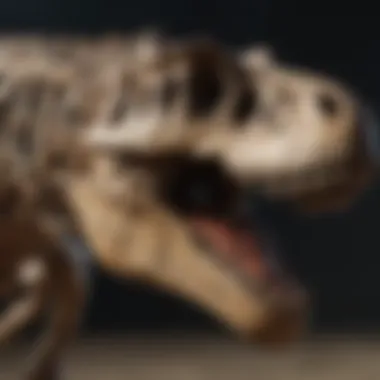Unveiling the Enigmatic World of Fossils: An Extensive Guide


Rock and Fossil Identification
Fossils serve as remarkable windows into the geological and biological history of our planet, holding clues to ancient life forms and past environments. In the quest to understand these remnants of the past, it is imperative to delve into rock and fossil identification. Various types of rocks and fossils exist, ranging from sedimentary to igneous, each holding distinct characteristics that offer insights into their formation and geological context. When embarking on the journey of identification, certain key characteristics to look for include texture, color, structure, and the presence of unique markings or imprints. Utilizing specialized tools such as hand lenses, magnifiers, and identification guides can facilitate the meticulous examination necessary for accurate classification.
Collecting Tips and Techniques
Collecting fossils is akin to uncovering hidden treasures from the depths of time, requiring precision, patience, and a keen eye. To ensure the best practices for collecting, aspiring fossil hunters should familiarize themselves with the geological history of potential sites, understanding the specific conditions conducive to fossil formation. Locating prime collecting sites involves researching areas with exposed rock layers, sedimentary deposits, or sites with historical fossil discoveries. Careful extraction of specimens is essential to preserve them intact and avoid damage. Implementing techniques such as gentle brushing, digging tools, and protective gear can aid in the safe extraction of delicate fossils.
Preservation and Display
Preserving and displaying fossils is an art form that requires a delicate balance of science and creativity. Techniques for preserving rocks and fossils vary depending on their composition and state of conservation. Methods such as cleaning, stabilizing, and protective coating help maintain the integrity of fossils over time. Proper storage methods involve utilizing acid-free containers, temperature-controlled environments, and protection from light and moisture to prevent deterioration. When it comes to creative display ideas, showcasing fossils in shadow boxes, on stands, or in themed collections can enhance their aesthetic appeal while also conveying their scientific significance to viewers.
Geological Insights
Exploring the geological insights offered by rocks and fossils sheds light on the Earth's tumultuous history and evolutionary processes. Geological formations and processes provide vital context for understanding the deposition, formation, and fossilization of ancient remains. The historical significance of rocks and fossils unravels stories of extinct organisms, paleoenvironments, and evolutionary transitions that have shaped our planet. Notable discoveries in the field of paleontology have unearthed groundbreaking fossils such as dinosaur skeletons, early hominid remains, and ancient plant specimens, revolutionizing our understanding of life's evolution on Earth.
Introduction to Fossils
Fossils serve as crucial links to our past, providing invaluable insights into Earth's history and the evolution of life. In this comprehensive guide titled 'Exploring the World of Fossils,' we embark on a journey through time, uncovering the hidden treasures preserved within rocks and sediments. The introduction sets the stage for a deep dive into various types of fossils, their significance in paleontological research, and the methods used to reveal their ancient secrets.
Understanding Fossils
The Definition of Fossils
Exploring the concept of fossils, we encounter remains and traces of organisms preserved in the Earth's crust. These remnants act as snapshots of past life forms, offering scientists a glimpse into prehistoric ecosystems. The precise definition of fossils encompasses not only skeletal remains but also imprints, tracks, and other evidence of ancient organisms, fostering a multidimensional understanding of past life.
Considering its pivotal role in reconstructing Earth's history, the definition of fossils plays a fundamental part in this article by forming the basis for recognizing and interpreting ancient remains accurately. Its versatility in encompassing various forms of preservation ensures a comprehensive exploration of fossil diversity, enriching the study of evolution and biodiversity.
Importance of Fossils in Scientific Research
Fossils stand as the cornerstone of scientific research, providing tangible evidence of evolutionary processes and environmental changes over millennia. By studying fossils, researchers trace evolutionary lineages, uncover adaptations in response to shifting climates, and chart the emergence of diverse life forms. The importance of fossils in scientific research extends beyond paleontology, influencing fields such as geology, biology, and anthropology.
Within the context of this article, the significance of fossils in scientific research underscores the essence of understanding prehistoric life and ecosystem dynamics. Their contribution to interpreting ancient environments and biological interactions offers profound insights that shape our perception of Earth's geological past, making them an indispensable component of this exploratory guide into the realm of fossils.
Types of Fossils
Fossils play a crucial role in uncovering the mysteries of the past and understanding the evolution of life on Earth. In this section, we will delve deep into the various types of fossils that exist, shedding light on their significance in paleontology and scientific research. Understanding the different types of fossils is essential for piecing together the puzzle of ancient life forms and ecosystems. By exploring body fossils, trace fossils, and chemical fossils, we can gain valuable insights into the history of our planet and the organisms that once inhabited it.
Body Fossils


Body fossils are physical remains of ancient organisms, providing direct evidence of past life forms. They come in different forms, each offering unique information about prehistoric beings. Mineralized body fossils preserve the structure of organisms through the process of mineral replacement, offering detailed insights into their anatomy and morphology. These fossils are crucial for reconstructing the physical characteristics of extinct species and understanding their adaptations to their environments. While mineralized body fossils provide a wealth of information, they may be subject to deterioration over time, limiting the amount of detail that can be extracted.
Carbon films are another type of body fossil that captures an organism's outlines and external features. These fossils are typically formed when an organism decays, leaving a thin film of carbon residue. Carbon films are valuable for showcasing delicate structures such as leaves and soft tissues, offering a glimpse into the biodiversity of ancient flora. However, their delicate nature makes them susceptible to damage and degradation, requiring careful handling during excavation and preservation processes.
Original material fossils preserve the organic remains of organisms, such as proteins, soft tissues, or DNA. These fossils provide unprecedented opportunities for studying ancient biological molecules and unlocking evolutionary secrets. Original material fossils offer a direct link to the past, allowing researchers to analyze the genetic makeup of extinct species and explore their relationships with modern organisms. Despite their scientific significance, the preservation of original material fossils is challenging due to the complexities of organic decay and fossilization processes.
Trace Fossils
Trace fossils offer indirect evidence of ancient life activities, revealing the behaviors and movements of organisms through imprints and tracks. Ichnofossils, which include footprints and other traces left behind by organisms, provide insights into their locomotion and social interactions. These fossils are like snapshots of past ecological interactions, offering glimpses into the behaviors of long-extinct creatures. While ichnofossils lack the physical remains found in body fossils, they paint a vivid picture of ancient ecosystems and animal behavior.
Burrows and borings are traces left by organisms as they tunnel through sediments or wood, leaving distinctive structures that can be preserved over geological timescales. These fossilized structures provide clues about the ecological niches occupied by ancient organisms and their burrowing behaviors. By studying burrows and borings, researchers can reconstruct ancient habitats and understand the roles of organisms in ecosystem dynamics.
Tracks and traces constitute imprints of movements and activities left behind by organisms, such as footprints, tail drags, or feeding marks. These fossils offer a glimpse into the daily lives of prehistoric creatures, showcasing their interactions with the environment and other organisms. Analyzing tracks and traces can reveal valuable information about locomotion patterns, feeding behaviors, and predator-prey relationships in ancient ecosystems.
Chemical Fossils
Chemical fossils are molecular remnants of ancient organisms that have been preserved in rock formations. Lipids, proteins, and nucleic acids are examples of chemical fossils that provide biochemical insights into past life forms. Lipids, commonly found in cell membranes and tissues, can be used to trace the evolutionary relationships between organisms and analyze ancient dietary habits. Proteins, crucial for cellular functions, offer clues about the biological processes and adaptations of extinct species. Nucleic acids, such as DNA fragments, hold the potential for genetic analyses and comparisons with modern genetic sequences.
Understanding chemical fossils unlocks a wealth of information about the biochemistry and molecular biology of ancient organisms, complementing traditional paleontological studies. By examining the chemical signatures preserved in rocks, researchers can reconstruct ancient ecosystems, chart evolutionary pathways, and reveal hidden links between past and present life forms. Chemical fossils provide a unique window into the biochemical complexity of ancient life, enriching our understanding of the biological mechanisms that shaped the evolutionary history of terrestrial and marine organisms.
Implications of Fossil Discoveries
The section on Implications of Fossil Discoveries in this article delves into the vital roles fossils play in unraveling Earth's history. Fossil discoveries offer invaluable insights into evolutionary processes, enabling scientists to trace ancestral lineages and study adaptations over time. By examining fossils, researchers gain a deeper understanding of how organisms have evolved and adapted to changing environments. These discoveries provide a window into the past, allowing us to piece together the puzzle of life on Earth and comprehend the intricate connections between different species.
Evolutionary Insights
Tracing Ancestral Lineages
Tracing Ancestral Lineages forms a cornerstone of paleontological research, offering a glimpse into the evolutionary history of organisms. This aspect allows scientists to reconstruct the genetic relationships between species and track the development of traits over generations. By examining the morphological and genetic similarities between fossils, researchers can establish phylogenetic relationships and map out the evolutionary tree of life. Tracing Ancestral Lineages is a fundamental tool in deciphering the origins of species and understanding the mechanisms driving evolutionary change, making it a crucial component of this article's exploration of fossils.
Adaptations Over Time
The concept of Adaptations Over Time highlights how organisms have responded to environmental challenges through evolutionary changes. This aspect focuses on studying how species have adapted their anatomical, physiological, and behavioral traits to survive and thrive in different habitats. By analyzing fossil records, scientists can infer how organisms have evolved specific adaptations in response to changing climatic conditions, competition, and predation pressures. Understanding Adaptations Over Time not only sheds light on past evolutionary processes but also provides valuable insights for predicting how organisms may adapt to future environmental changes, enriching the narrative of this article on fossil discoveries.
Paleoenvironmental Reconstruction
Climate Conditions
The analysis of Climate Conditions in paleoenvironmental reconstruction is critical for understanding how environmental factors have influenced evolutionary trajectories. By examining proxies such as fossilized flora and geochemical signatures, scientists can infer past temperature, precipitation patterns, and atmospheric composition. This aspect helps reconstruct ancient climates, identify shifts in global environmental conditions, and elucidate how these changes have impacted species evolution. Understanding Climate Conditions contributes significantly to unraveling past ecosystems' dynamics and their interconnectedness with evolving life forms, underscoring its relevance in this article's comprehensive guide to fossil exploration.


Ecosystem Dynamics
Ecosystem Dynamics focuses on the interactions between organisms and their environment over geological time scales. This aspect considers how changes in species distributions, biodiversity patterns, and ecological niches have shaped ecosystems throughout Earth's history. By analyzing fossil assemblages and ecological relationships, researchers can reconstruct past food webs, species interactions, and environmental disturbances. Exploring Ecosystem Dynamics allows for a holistic understanding of ecosystem evolution and the interconnectedness of species within prehistoric environments, enriching the narrative of this article on fossil discoveries.
Preservation Techniques
Understanding the preservation techniques within the domain of fossils is paramount in maintaining the integrity and longevity of these ancient remnants. By carefully preserving fossils, we ensure that valuable information about prehistoric life is safeguarded for future generations. The preservation techniques discussed in this article shed light on the methods used to protect and study fossils, highlighting their significance in unraveling the mysteries of the past.
Conventional Methods
Preservation techniques are the cornerstone of paleontology, with conventional methods playing a crucial role in maintaining fossil specimens. These traditional techniques encompass a range of processes designed to prevent decay and deterioration, preserving the delicate structures trapped within the rock.
Desiccation
Desiccation, a primary method of fossil preservation, involves the removal of moisture from the specimen to inhibit microbial growth and decomposition. This technique is particularly effective for desiccating soft tissues, such as plant matter or delicate animal remains, ensuring their long-term survival. The key characteristic of desiccation lies in its ability to prevent microbial colonization, thereby halting the decay process and maintaining the fossil's integrity. While desiccation is a popular choice for its simplicity and efficacy, it requires controlled environmental conditions to prevent rehydration and potential damage to the specimen.
Freezing
Freezing, another conventional preservation method, entails the rapid cooling of fossil samples to sub-zero temperatures to halt microbial activity and decay. This technique is favored for its ability to retain organic materials without the need for chemical additives. The key characteristic of freezing lies in its ability to act as a natural preservative by essentially 'locking in' the fossil's structure and content. Despite its advantages in preserving fragile tissues, freezing may pose challenges in terms of storage and transportation, requiring specialized facilities to maintain the required temperature conditions.
Chemical Preservation
Chemical preservation involves the use of various substances, such as preservatives and consolidants, to prevent fossil degradation and enhance stability. This method aims to replace water and other organic components within the fossil's structure with durable compounds, thereby fortifying its overall resilience. The key characteristic of chemical preservation is its versatility in treating different types of fossils, from soft-bodied organisms to mineralized remains. While chemical preservation offers comprehensive protection against decay, careful consideration must be taken to ensure the compatibility of chemicals with the fossil's composition and long-term effects on its preservation.
Advanced Preservation Technologies
Innovations in preservation technologies have revolutionized the field of paleontology, offering new ways to document and analyze fossils with enhanced accuracy and detail. These advanced techniques leverage cutting-edge methods to extract intricate information from fossils, opening up new avenues for research and exploration.
Resin Encasement
Resin encasement involves immersing fossils in a hardened resin matrix, creating a protective shell around the specimen to safeguard its structure and prevent deterioration. This technique is valued for its ability to preserve delicate details and provide structural support to fragile fossils. The unique feature of resin encasement lies in its capacity to capture fine features with minimal alteration, allowing researchers to examine specimens in their original state. While resin encasement offers unparalleled protection, it may pose challenges in terms of access to the enclosed fossil and potential alterations during the encasement process.
CT Scanning
CT scanning, a non-invasive imaging technique, allows for detailed 3D visualization of fossil specimens without physically altering the sample. This advanced technology provides researchers with internal views of fossils, revealing hidden structures and anatomical features with high precision. The key characteristic of CT scanning is its ability to generate precise digital reconstructions of fossils, enabling thorough analysis and documentation for scientific study. While CT scanning offers unparalleled insights into fossil morphology, it may require specialized equipment and expertise for optimal results.
Digital Reconstruction
Digital reconstruction utilizes advanced software to create virtual models of fossils based on imaging data, reconstructing their original appearance and context in a digital format. This innovative approach facilitates detailed analysis and manipulation of fossil structures, offering researchers the ability to virtually 'excavate' and study specimens without the risk of physical damage. The unique feature of digital reconstruction lies in its potential to enhance collaboration and accessibility, allowing researchers to share and analyze fossil data across global networks. While digital reconstruction streamlines research efforts, it may introduce challenges in terms of accuracy and interpretation, requiring validation against physical specimens for completeness.


Notable Fossil Discoveries
In this segment of the comprehensive guide on exploring the world of fossils, we delve into the fascinating realm of notable fossil discoveries. These discoveries play a crucial role in advancing our understanding of prehistoric life forms and evolutionary history. By shedding light on exceptional fossil finds, scientists can piece together intricate narratives of ancient ecosystems and species.
At the heart of notable fossil discoveries lies the Tyrannosaurus Rex skeleton, a specimen that has garnered immense attention and scientific significance. This iconic dinosaur fossil provides invaluable insights into the biology and behavior of the tyrant lizard king that once roamed the Earth. Through meticulous excavation and research, paleontologists have been able to reconstruct the skeletal structure of the T-Rex, offering a glimpse into its formidable stature and predatory capabilities.
Tyrannosaurus Rex Skeleton
Paleontological Significance
The Paleontological Significance of the Tyrannosaurus Rex skeleton signifies a remarkable milestone in paleontological research. This colossal predator, with its massive skull, razor-sharp teeth, and powerful limbs, represents a pinnacle of dinosaur evolution during the Late Cretaceous period. The discovery of T-Rex fossils has provided vital clues about the anatomy, locomotion, and feeding habits of these apex predators, shaping our understanding of ancient ecosystems and predator-prey dynamics.
The uniqueness of the Tyrannosaurus Rex skeleton lies in its exceptional preservation and completeness, allowing scientists to conduct detailed anatomical studies and biomechanical analysis. By studying the morphology and bone structure of this fossil specimen, researchers have uncovered crucial information about T-Rex physiology and evolutionary adaptations, contributing significantly to the field of paleontology.
Scientific Impact
The Scientific Impact of the Tyrannosaurus Rex skeleton extends far beyond paleontological realms, transcending into popular culture and scientific discourse. This iconic fossil has captured the imagination of both experts and the general public, influencing depictions of dinosaurs in movies, books, and museums. The T-Rex's formidable reputation as a fearsome carnivore has made it a symbol of power and prehistoric prowess, solidifying its place as one of the most recognizable dinosaurs in history.
Moreover, from a scientific perspective, the T-Rex skeleton has revolutionized our knowledge of dinosaur biomechanics, feeding behavior, and evolutionary relationships. Studies based on T-Rex fossils have revealed evolutionary links between theropod dinosaurs and modern birds, providing compelling evidence for the evolutionary relationship between dinosaurs and avian species. By deciphering the scientific implications of this iconic fossil discovery, researchers continue to unravel the mysteries of dinosaur evolution and ecological dynamics.
Archaeopteryx Fossil
Transitional Fossil
The Archaeopteryx Fossil stands out as a pivotal transitional fossil that bridges the evolutionary gap between dinosaurs and birds. This remarkable specimen exhibits characteristics of both reptiles and birds, showcasing feathered wings and reptilian features in exquisite detail. The Archaeopteryx fossil provides compelling evidence for the evolutionary transition from terrestrial theropod dinosaurs to avian creatures, offering valuable insights into the origins of flight and avian locomotion.
A distinctive feature of the Archaeopteryx fossil is its feathered plumage, which represents an evolutionary innovation in vertebrate history. The presence of well-preserved feathers in this fossil specimen has provided critical clues about the development of flight in early avian species, shedding light on the evolutionary trajectory of feathered dinosaurs towards modern birds.
Feather Evolution Clues
The Feather Evolution Clues embedded within the Archaeopteryx Fossil offer crucial insights into the evolutionary history of feathers and avian adaptations. By examining the intricate feather structures preserved in this fossil, scientists have uncovered the developmental stages of early feather evolution, tracing the origins of flight-related features in avian lineages. The presence of primitive feather types in the Archaeopteryx fossil signifies a pivotal stage in feather evolution, highlighting the gradual transformation of scales into feathers during avian evolution.
Furthermore, the feather morphology and arrangement in the Archaeopteryx fossil provide valuable information about the aerodynamic properties of early birds and their ability to achieve powered flight. Through detailed analysis of feather structures and patterns in this fossil specimen, researchers have pieced together the evolutionary puzzle of avian locomotion, showcasing the adaptive significance of feathers in enhancing flight capabilities.
Conclusion
Unveiling Earth's Past
Rich History Encased in Stone
Within the domain of fossils lies the intriguing concept of 'Rich History Encased in Stone,' a phenomenon that captures the timeline of Earth's evolution in meticulous detail. This particular aspect serves as a cornerstone in our quest to comprehend the past, offering a tangible link to bygone eras through the imprints left within fossilized remains. Its significance within this article lies in providing a tangible connection to ancient epochs, showcasing the enduring nature of geological records that have withstood the test of time. The allure of 'Rich History Encased in Stone' stems from its ability to narrate tales of ancient life forms, climate variations, and evolutionary shifts, making it a cornerstone of scientific inquiry and historical documentation within the fossil exploration domain.
Continuous Exploration and Learning
The facet of 'Continuous Exploration and Learning' stands as a testament to the dynamic nature of fossil studies, emphasizing the perpetual quest for knowledge and understanding. In the context of this article, it plays a pivotal role by highlighting the iterative process of discovery and analysis that characterizes the field of paleontology. The relentless pursuit of unearthing new fossils, deciphering their significance, and synthesizing evolving narratives contributes to a vibrant landscape of scientific inquiry and intellectual curiosity. While posing challenges in terms of logistical expediency and resource constraints, the ethos of 'Continuous Exploration and Learning' propels scientists and enthusiasts alike towards new frontiers of discovery, creating a legacy of ingenuity and innovation in the exploration of Earth's ancient past.







